Charcoal is one of the most popular and versatile fuel sources used for outdoor grilling. While it may seem easy to light up the grill and throw in some charcoal, seasoned grillers know that properly timing the charcoal can greatly impact their cooking results. A common question among grillers is, “when is charcoal ready?” The answer to this question varies depending on the lighting method and the desired cooking temperature. In this article, we’ll break down the different indicators that charcoal is ready for grilling, from the color and texture of the coals to the grill’s temperature. With these tips, you can perfect your grilling game and cook mouthwatering meals every time.
Understanding Charcoal and Its Uses for Grilling
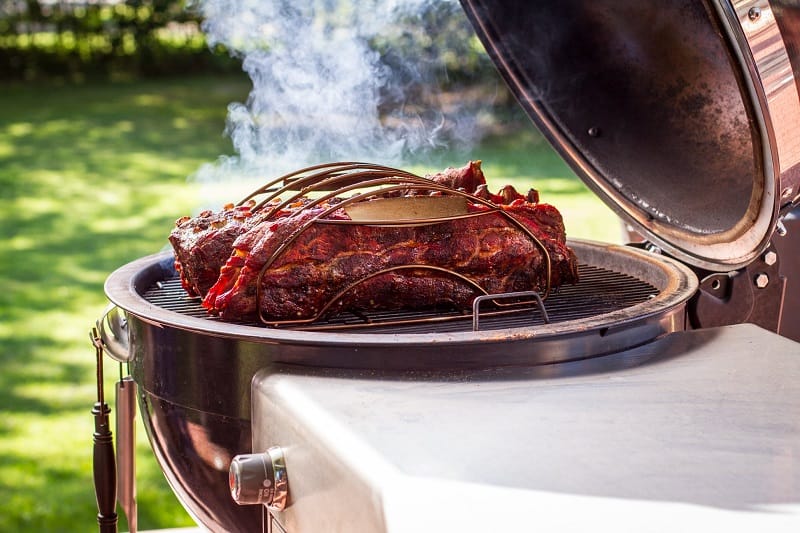
When it comes to grilling, charcoal is the fuel of choice. Charcoal is made by burning wood, usually hardwood, at a low temperature for an extended period of time. This process removes all the water, gases, and other compounds from the wood, leaving behind a pure form of carbon. This carbon is what we know as charcoal.
Charcoal is available in various forms, including briquettes, lump charcoal, and hardwood lump charcoal. Briquettes are made from compressed sawdust or other wood particles and are usually uniform in size and shape. They burn evenly and produce consistent heat. Lump charcoal is made from larger pieces of wood that have been burned without oxygen and are perfect for grilling because it has a higher temperature and longer burning time. Hardwood lump charcoal is made from various hardwoods and is popular for its fuller flavor and aroma.
When using charcoal for grilling, it’s important to understand the basics of how it works. Charcoal produces heat when it’s ignited, and the heat is transferred to the food through the surface of the charcoal. The higher the temperature of the charcoal, the more heat it will transfer to the food. The heat is released into the air when the food is cooked, and the charcoal will start to cool.
Charcoal can be lit in a variety of ways. The most common is with a chimney starter, which uses a small amount of newspaper and charcoal to create a hot bed of coals. You can also use a charcoal chimney, which uses a small amount of charcoal and air to start the fire. Another option is to use a lighter or match to light the charcoal.
When using charcoal for grilling, remember a few tips and tricks. Make sure the charcoal is completely cooled before adding food. Charcoal can stay hot for a long time, so it’s essential to wait until it’s cooled down before adding food. Also, keep an eye on the temperature of the charcoal while grilling, as it’s important to maintain even heat throughout the cooking process.
Understanding charcoal and its uses for grilling can help you make the most of your grilling experience. With the right tools and techniques, you can enjoy delicious food cooked over charcoal every time.
Tips for Speeding Up the Charcoal Lighting Process
The first tip is to use a charcoal chimney starter. These tools allow you to light your coals quickly and evenly, using only a small amount of fuel. Add the charcoal to the chimney and use a standard lighter or match to ignite the fuel. As the fuel burns, it will spread the heat to the charcoal, allowing it to light quickly and evenly.
Another tip is to invest in quality charcoal. High-quality charcoals are designed to light faster and burn hotter, making them ideal for grilling. They also tend to be less messy, so you won’t have to worry about ash and sparks flying around.
If you’d rather not invest in a charcoal chimney starter, you can also use an electric charcoal starter. These are typically sold in stores and are easy to use. Plug it in, add your charcoal, and press the button. The electric starter will heat the charcoal quickly and evenly, allowing you to get your coals lit in no time.
Finally, you can use a fire starter cube or log to light your charcoal. These are typically made of sawdust and wax; all you have to do is light the cube and add charcoal. The fire starter will act as a fuel source to light the charcoal, allowing it to burn quickly and evenly.
Following these simple tips, you can speed up your charcoal lighting process and get your food on the grill in no time. Always stay safe when using charcoal; use it outdoors in a well-ventilated area.
When Is Charcoal Ready?
When it comes to grilling with charcoal, timing is everything. Knowing when the charcoal is ready for cooking is essential to ensure that your food is cooked perfectly. According to factual data, charcoal is ready when most briquettes turn white or gray. This indicates that they have reached a high temperature and are ready for cooking. Charcoal typically takes 20-30 minutes to become fully lit and ready for cooking, but there are ways to speed up the process.
Once the charcoal is ready, it’s important to wait a few minutes before placing food on the grill grates. This allows the heat to distribute evenly and ensures your food cooks evenly. Overall, it’s essential to be patient and wait until the charcoal has fully heated before grilling.
What Is The Best Temperature For Charcoal When Grilling Meat?
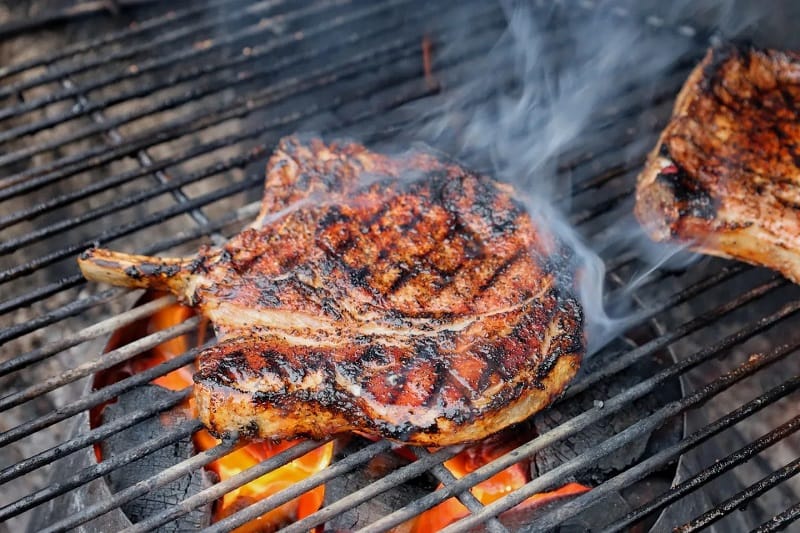
Based on factual data, the ideal temperature range for grilling meat on charcoal is between 450°F and 650°F. This high heat is recommended when preparing steaks, pork chops, kabobs, or tuna steak. However, right after the coals are dumped from the chimney, the heat is extreme—too hot to cook almost anything.
The best approach is to let the coals cool down and aim for a temperature around 500°F. Charcoal grills’ 700-degree maximum temperatures make them the best choice for steaks, burgers, and other thick, dense foods and for achieving that perfect charred crust.
So, if you want to impress your guests with your grilling skills, brush your cooking grates clean, adjust your grill for direct, high heat, and aim for a temperature range between 450°F and 650°F for the best results.
How Long Should You Let Charcoal Burn Before Adding Food On The Grill?
According to factual data, one should let the charcoal burn until it’s covered in white-grey ash, which usually takes about 20-30 minutes. After lighting the grill, it’s typically best to cover it with the lid and let it sit for five to 10 minutes before adding food over the coals.
Additionally, the grill needs to get good and hot before adding food. If using charcoal or briquettes, leave them on the flame for 5 to 10 minutes, followed by 25 to 30 minutes of medium heat. Following these guidelines ensures that the charcoal is evenly distributed and hot enough to grill delicious food.
What Are The Different Ways To Light Charcoal For BBQ?
1. Charcoal Chimney
Using a charcoal chimney is the most efficient and safe way to light charcoal. Simply place crumpled newspaper in the bottom, fill the chimney with charcoal, light the newspaper, and wait for the coals to ash over. This method is inexpensive, clean, and doesn’t affect the taste of your food.
2. Electric Charcoal Starter
This method involves using an electric charcoal starter to heat the coals. Simply place the starter among the charcoal and let it sit for 8-10 minutes. Although this method can be efficient, it requires an electrical outlet and may produce a metallic taste in your food.
3. Fan-assisted Charcoal Starter
This method uses a fan-assisted charcoal starter to heat the coals quickly and evenly. Simply place the starter among the charcoal, turn on the fan, and wait for the coals to ash over. This method can be efficient and fast, but it can also be expensive and produce a metallic taste in your food.
4. Douse Coals in Rubbing Alcohol
A popular technique involves dousing your charcoal in rubbing alcohol before lighting. Although this method can be fast, it increases the risk of starting a dangerous fire and produces a strong chemical smell. We recommend using this method with caution.
5. Using Lighter Fluid
Using lighter fluid is a popular yet controversial method for lighting charcoal. Although it can be efficient, it’s dangerous and leaves a chemical residue on your food. We recommend avoiding this method and using any of the safer options mentioned above.
Should Charcoal Be White Before Cooking?
When charcoal is lit, it begins to turn white. This is because of a chemical reaction between the oxygen in the air and the charcoal. This reaction is called “pyrolysis,” and it’s what creates the heat that is used for cooking food. The heat generated by charcoal differs from that generated by gas or electric grills. Charcoal heat is more intense and can reach temperatures much higher than gas or electric grills (sometimes up to 1000 degrees Fahrenheit).
So, should charcoal be white before cooking? It depends. Generally, lighter-colored charcoal will reach a higher temperature faster than darker-colored charcoal. This means lighter-colored charcoal should be used for high-temperature cooking like searing or grilling steaks. Darker charcoal should be used for lower-temperature cooking, like smoking or slow-roasting.
Charcoal can also be used to create different flavor profiles. White charcoal has a milder flavor than black charcoal, which has a stronger smoky flavor. So, depending on the type of food you’re cooking and the flavor you’re looking for, you can choose between lighter and darker charcoal.
Read more:
Does Charcoal Heat Faster With the Lid On Or Off?
Does charcoal heat faster with the lid on or off? It’s a question that has long divided barbecue aficionados and backyard chefs alike. The answer isn’t as clear-cut as you might think.
The most common type of charcoal is lump charcoal. Lump charcoal burns hotter and faster than briquettes, so it’s usually the better choice when you’re looking for a quick and hot cooking experience. If you’re using lump charcoal, the lid should generally be off. This will allow the heat to escape more effectively, resulting in faster and hotter cooking.
If you’re using charcoal briquettes, the lid should generally be on. The lid will help to trap the heat, making the briquettes burn slower and more evenly. This is ideal if you’re looking to cook something slowly and evenly.
It’s also worth noting that the size of your grill will affect the answer. If you’re using a smaller grill, it’s best to keep the lid off. The lid will trap the heat and quickly make the grill too hot. The lid should generally be on if you’re using a larger grill. This will help to spread the heat more evenly and help to cook your food more evenly.
Overall, the answer to whether charcoal heats faster with the lid on or off depends on the type of charcoal, the size of your grill, the amount of charcoal you’re using, and the temperature you’re aiming for. If you’re looking for a quick and hot cooking experience, it’s best to use lump charcoal and keep the lid off. If you’re looking for a slow and even cooking experience, it’s best to use charcoal briquettes and keep the top on.
Best Practices for Arranging Charcoal in Your Grill
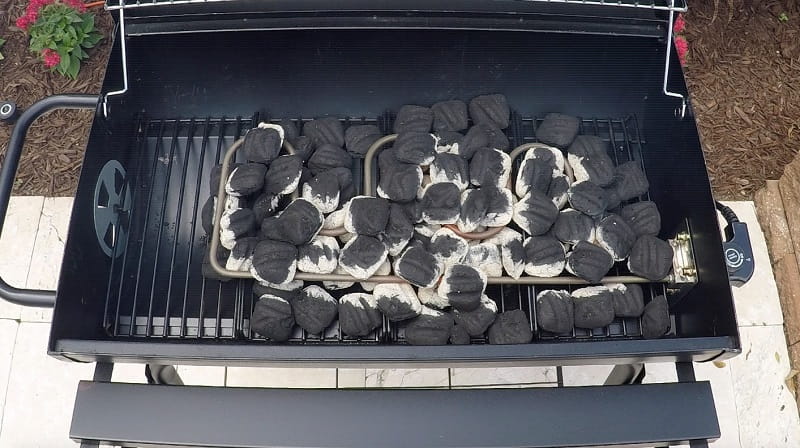
Cooking over charcoal is much more than just throwing a few briquettes into the grill and lighting them. The proper charcoal arrangement can help ensure you get an even, consistent heat that will help you perfectly cook your food.
First and foremost, you’ll want to use the right type of charcoal for your grill. Charcoal briquettes are made of compressed charcoal dust, sawdust, and other materials and are the most popular charcoal for grilling. Lump charcoal is simply pieces of wood that have been burned down to charcoal and are a great choice for grilling food quickly over high heat.
Next, it’s essential to consider the placement of your charcoal. You’ll want to position the charcoal so it’s evenly distributed at the bottom of the grill. Using a charcoal grill, use the 2-Zone method to arrange the charcoal. This method involves arranging the charcoal in two piles, one on each side of the grill. This way, you’ll be able to achieve both direct and indirect heat for cooking food.
Once the charcoal is arranged, it’s time to light it. You’ll want to use a quality fire starter to light the charcoal. This will help to ensure that the charcoal lights evenly and burns consistently. If you’re using briquettes, you’ll want to place the fire starter on top of the charcoal and light it with a long match. Place the fire starter in the center of the charcoal for lump charcoal and light it with a match.
Finally, you’ll want to monitor the temperature of your charcoal as you cook. There are several ways to do this, including using an oven or digital thermometer. Keeping an eye on the temperature will help ensure your food is cooked evenly and perfectly.
Can You Use Lighter Fluid To Start Charcoal, Or Is There A Better Alternative?
Starting a charcoal fire is essential for any outdoor cooking endeavor, whether a backyard barbecue or a camping trip. While there are many methods for getting a charcoal fire started, one of the most common methods is to use lighter fluid. But is this the best way to start your charcoal fire, or is there a better alternative?
The most popular way to start a charcoal fire is to use a liquid fuel such as lighter fluid. These fuels are easy to use and readily available at most stores. All you need to do is pour some liquid fuel onto the charcoal, light it, and wait for the fuel to burn off before adding more charcoal.
While this method is fairly straightforward and easy to use, there are some downsides to using lighter fluid. For one thing, it can be dangerous if not used properly. If you don’t light the liquid correctly, it can cause a flare-up, which can be dangerous. Additionally, lighter fluid can leave an unpleasant taste and odor on your food, which can be off-putting for some people.
Fortunately, there are some safer alternatives to lighter fluid. One of the best alternatives is to use a chimney starter. These devices are metal cylinders with a grate at the bottom, where you place the charcoal. Then, light some crumpled newspaper and place it at the bottom of the chimney. As the newspaper burns, it will heat the charcoal, which will eventually start to burn.
Using a chimney starter is a much safer way to start a charcoal fire than using lighter fluid. It’s also much easier to use than lighter fluid and doesn’t leave any unpleasant taste or odor on the food.
Another alternative to using lighter fluid is to use an electric charcoal starter. These electric coils heat the charcoal, causing it to burn. They’re much easier to use than lighter fluid and don’t pose any safety risks.
How to Monitor Charcoal Temperature While Cooking
When cooking over a charcoal grill, monitoring the temperature is important to ensure your food cooks evenly and doesn’t burn. To do this, the grillmaster should use both dampers for proper temperature control. The intake damper controls the amount of oxygen that enters the grill and fuels the fire, while the exhaust damper controls the smoke and heat that escapes the grill.
The grillmaster should start by placing the lit coals evenly on the grate for a single-zone fire. They can then adjust the dampers to increase or decrease the temperature. If the temperature is too high, the grillmaster can partially close the intake damper to reduce oxygen and lower the heat. On the other hand, if the temperature is too low, they can open the intake damper wider to allow more oxygen in and raise the heat.
How Long Does It Take For Charcoal To Completely Burn Out?
In most cases, charcoal will stay hot for as long as an hour, provided that the fire has been kept up and maintained properly. However, it’s important to note that the length of time can vary depending on several factors, such as how well the fire has been tended to and the amount of charcoal used.
To put out the charcoal, it’s recommended to simply shut the lid and leave it for up to two days to let it completely burn out. This is the safest and most effective method of extinguishing fire and avoiding potential hazards. Additionally, it’s important to dispose of the ashes and charcoal properly to avoid any fire risks.
How to Maintain Your Charcoal Grill for Optimal Performance?

Maintaining a charcoal grill is essential to ensuring optimal performance and longevity. There are several things to remember to keep a charcoal grill clean and in good condition.
- It’s essential to wipe down the lid and bowl while cool to the touch, using a mild detergent soap or glass cleaner to eliminate any excess debris.
- Also, always clean the grates after every use and empty any ashes from the bowl or ash catcher. Remove the grill grates and ash catcher for deep cleaning, spray oven cleaner, and let sit for several hours.
- Invest in a good temperature probe to stabilize the grill at the desired temperature.
- Additionally, inspect the chassis regularly and shut down the oxygen intake supply to cool down the grill.
Troubleshooting Common Charcoal Grilling Problems
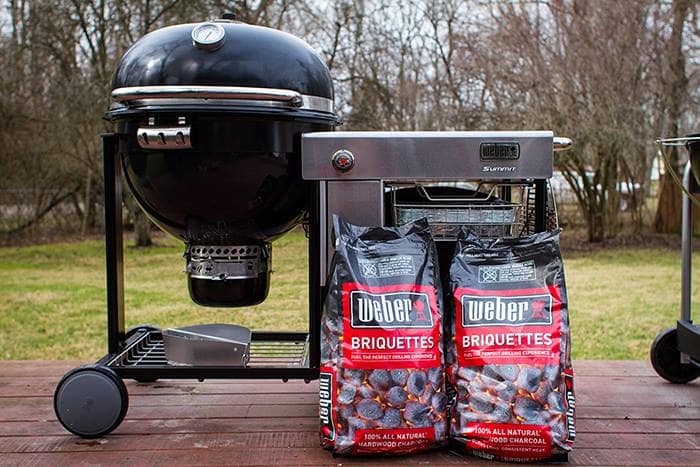
Having a backyard BBQ can be an enjoyable event for family and friends. However, sometimes things can go awry when it comes to charcoal grilling. Fortunately, several common problems can be easily solved with troubleshooting techniques.
- One of the most common issues is flare-ups caused by fat dripping onto the coals or grill bars. Trimming excess fat before grilling can help reduce this problem.
- Uneven heating is another common issue, usually caused by blocked burners.
- Ensuring the grill is clean and properly ventilated can also help.
- The burners, not lighting, could be due to a problem with the ignitor, but this can be resolved by manually lighting the burners.
- Lastly, using partially used charcoal can cause the grill not to get hot enough for cooking.
Safety Tips for Handling Hot Charcoal and Ashes
When it comes to handling hot charcoal and ashes, safety should be the top priority. It is important to allow ashes to cool down completely for at least 48 hours before disposing of them. To speed up the process, one can douse the coals with water and stir them to cool them off completely. A great way to dispose of cold ashes is by wrapping them in heavy-duty aluminum foil before throwing them away.
To ensure that the charcoal grill is safe, it is crucial to choose a safe location for the grill and always keep a close eye on it while in use. After cooking, the grill’s vents should be closed to prevent leftover coals from reigniting.
FAQs About When Is Charcoal Ready
How Do You Prevent Flare-Ups When Grilling Over Charcoal?
Following these simple steps, anyone can become a pro at grilling over charcoal without worrying about flare-ups.
- First, they should minimize the amount of fat and oil on the food they grill, as chicken, steaks, and burgers will all drip fat. To do that, they should trim off as much excess fat from their meat as possible.
- Second, they should wipe the grease catch-pan or cup each time before grilling.
- Third, they should ensure a charcoal-free zone by stacking the charcoal on both sides of the bowl and leaving an area clean in the center.
- Finally, if they have a flare-up, they should move the food back over the coals once it subsides and keep a close eye to ensure it doesn’t happen again.
What Is The Difference Between Direct And Indirect Heat When Grilling Over Charcoal?
When it comes to grilling over charcoal, there are two main ways to cook: direct and indirect heat. Direct heat grilling involves cooking food directly over the heat source, while indirect heat grilling involves placing food adjacent to the heat source and cooking with the grill lid closed.
The primary difference between these two methods is the level and intensity of heat used.
- Direct heat grilling is hotter and quicker than indirect heat grilling, making it ideal for burgers and steaks.
- Indirect heat grilling produces a slow, low heat similar to roasting and is perfect for larger cuts of meat like roasts and whole chickens.
Is It Safe To Use Newspaper To Start Charcoal, Or Should You Avoid It Altogether?
While a newspaper is a great option for kindling, it may not be the safest method for starting charcoals. The fumes from the chemical ink in the paper can be unhealthy and unpleasant to breathe in. Therefore, it is always better to use natural fire starters such as recycled paper or kindling to light your charcoal. If you decide to use newspaper, be cautious when lighting it as the paper can quickly ignite, causing a fire hazard.
What Are The Advantages Of Using Natural Lump Charcoal Over Charcoal Briquettes?
If you’re looking for high-quality fuel for grilling or smoking, natural lump charcoal might be your best option. This charcoal is made by burning wood in an oxygen-poor environment until it turns into pure carbon. Unlike charcoal briquettes, which often contain additives and fillers, lump charcoal is 100% natural and impurities-free. This gives it a cleaner burn, allowing you to achieve a more authentic taste and flavor in your food.
Lump charcoal also burns hotter and faster than briquettes, making it ideal for searing and grilling. Its irregular shape adds more smoke and flavor to your food, producing less ash. While it might be more expensive than briquettes, many people find that the advantages of using natural lump charcoal are well worth it.
Is It Safe To Cook On Charcoal That Has Not Turned Completely Gray?

The answer is no. While it’s tempting to start cooking when you see a few grey patches on the coals, waiting until they are ashed is essential. Why? The reason is simple, black coals release a lot of smoke, which can give your food a harsh, bitter flavor.
In addition, black coals are not hot enough to cook food evenly, increasing the risk of foodborne illnesses. So, to ensure a safe and delicious grilling experience, always wait for your charcoal to turn fully gray before cooking your food.
Why Are Grill Marks Important In Cooking With Charcoal?
Grill marks are an essential part of cooking with charcoal that adds an appealing texture and visual aesthetic to grilled foods. Achieving the perfect grill marks can be challenging, but with the right technique, it can be easily done. The appearance of grill marks gives the impression of high-quality cooking and is considered a desirable feature in grilled food.
In addition to enhancing the dish’s appearance, grill marks help lock in flavor and moisture in the food. The marks are created when proteins on the meat surface denature and caramelize due to the heat of the flame or hot surface.
The art of flame broiling helps to achieve the perfect sear. It is essential to master techniques such as the right placement of the meat, the right temperature, and the right distance between the food and the coals. Using the right type of grill is also important, as charcoal grills tend to give the best grill marks, while gas grills may be slightly less effective.
Does The Weather Affect How Long It Takes For Charcoal To Reach The Right Temperature?
According to factual data, it may take longer for charcoal to reach the right temperature when the weather is colder. However, this should not add extra time to the overall cooking process. It is important to keep in mind that with colder temperatures, it may take longer for the charcoal to light. Once the charcoal is lit, it is recommended to spread the hot coals three inches out past the edges of the food to be grilled to ensure a consistent cooking temperature.
Also, maintaining a dry grill will help achieve and maintain the desired temperature. With patience and attention to detail, grilling with charcoal in cold weather is possible and still achieving delicious results.
Can You Reuse Charcoal From Previous Grilling Sessions, Or Is It Better To Start With Fresh Charcoal Each Time?
For those who enjoy grilling and smoking, there’s good news: charcoal can be reused after previous grilling sessions. It’s a waste to toss out barely-used charcoal after every cook. The best charcoal to reuse is the leftover charcoal from a fast grilling session, as it retains its quality and can be easily relit for the next cook.
However, one should be aware that attempting to light a chimney starter filled with used coals may not be successful, as the smaller pieces tend to fall through. For better heat control, combining fresh and old charcoal is recommended. Despite some challenges with relighting, reusing charcoal can be an economical and effective option for grill enthusiasts.
Is Charcoal Ash Toxic?
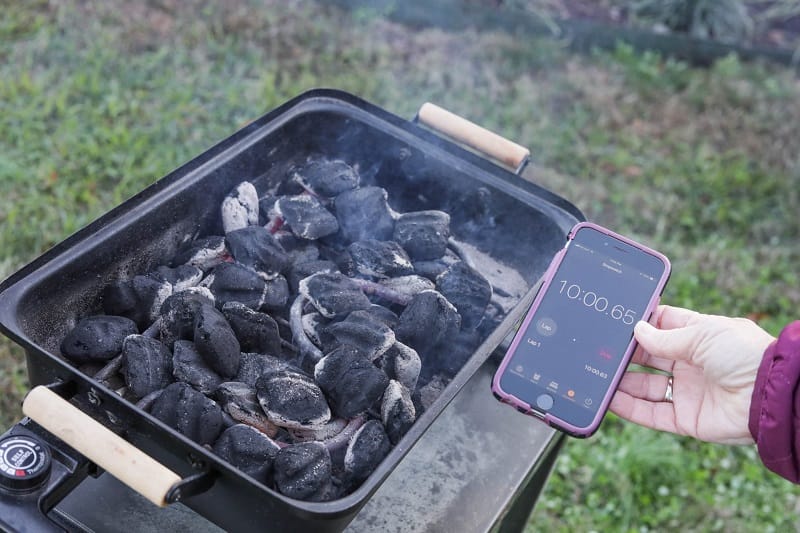
Charcoal ash is generally safe, but it’s essential to take some precautions to ensure that it doesn’t cause any harm. While pure ash from untreated charcoal can be used in your garden, ash from charcoal briquettes can contain toxins and residues that make it unsuitable for fertilizing.
Additionally, inhaling charcoal ash can potentially cause respiratory issues, and human ashes are highly alkaline and can cause significant damage. However, biochar is an eco-friendly fuel source that doesn’t contain harmful chemicals or synthetic ingredients. Using charcoal on your grill, use a good quality untreated variety.
Final Thoughts
Using charcoal as your fuel is a great way to get that delicious smoky flavor you want in your food. But it’s important to know when it’s ready for use. By following the steps above, you can ensure that your charcoal is ready and you can get cooking!
Now that you know when is charcoal ready, nothing is stopping you from trying this recipe today!
References:
- https://www.today.com/food/how-use-charcoal-grill-get-best-results-your-cookout-t94631
- https://www.kingsford.com/grill-guide/how-to-arrange-your-charcoal/
- https://www.huffpost.com/entry/charcoal_b_858606

Hey readers! Chip Holland here, and I’m a Manager of this website. My passion for writing about it only matches my passion for BBQ. Follow my blog for mouth-watering recipes, tips, and tricks for the perfect smoke, grill, and BBQ. I’m sure you won’t be disappointed!
